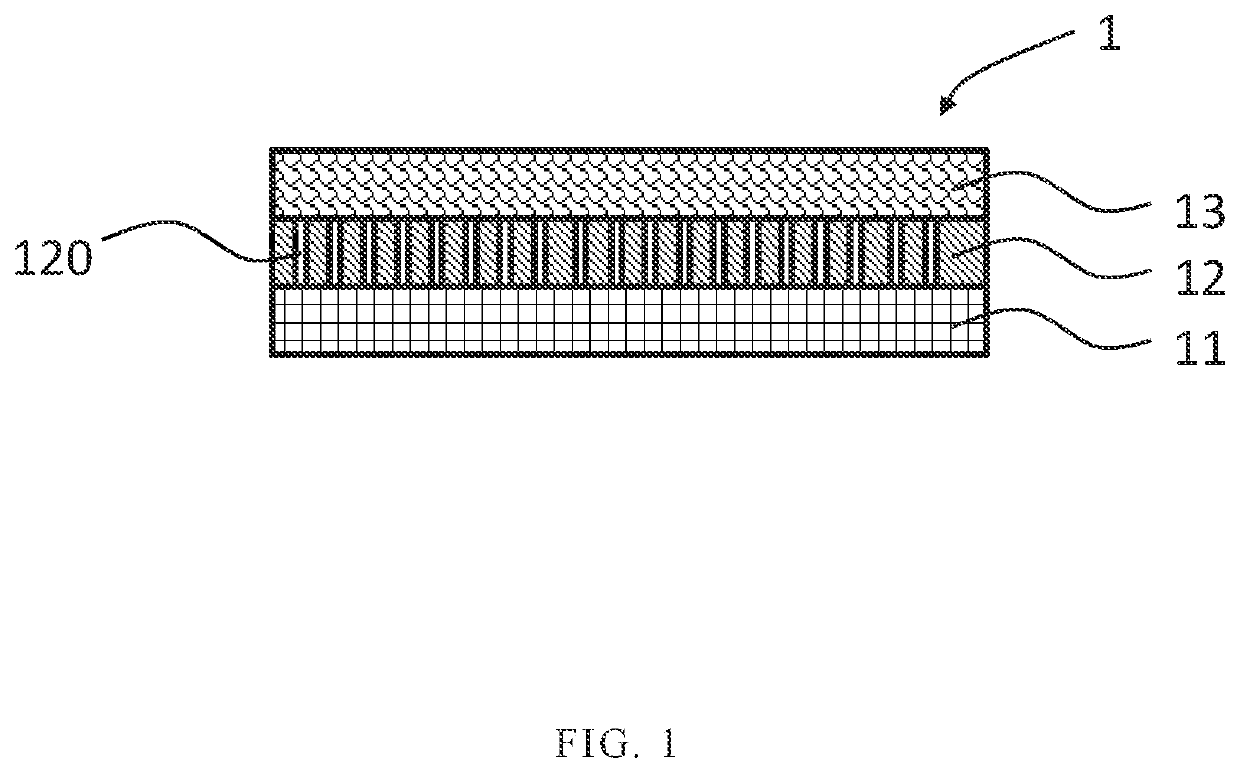Artificial leather structure and method for manufacturing the same
a technology of artificial leather and structure, which is applied in the direction of synthetic resin layered products, chemistry apparatus and processes, and other domestic articles, etc., can solve the problems of large amount of waste liquid requiring disposal, poor air permeability of artificial leather,
- Summary
- Abstract
- Description
- Claims
- Application Information
AI Technical Summary
Benefits of technology
Problems solved by technology
Method used
Image
Examples
example 1
[0063]Polyester pellets with an intrinsic viscosity (IV) of 1.0 were provided and subjected to a melt-spinning and drawing process to produce a PET fiber with a strength of 6.5 g / den, an elongation of 15%, and a fineness of 150 den. The polyester fiber was then subjected to a warp knitting process to produce a warp knitted fabric with a thickness of 0.3 mm, which was used as a woven layer.
[0064]A TPU film with the melting point of 118° C., the Shore A hardness of 50 A, and a thickness of 0.2 mm was provided and drilled the film with a hole diameter of 1.6 mm and a hole distribution density of 144 holes in 1 square inch to obtain a porous elastomer layer.
[0065]TPU ester pellets with the melting point of 160° C. and the Shore A hardness of 70 A were provided and subjected to a melt-blown process to blow the TPU fiber mesh onto the porous elastomer layer to form a nonwoven layer with a fiber mesh thickness of 0.5 mm.
[0066]The aforementioned nonwoven layer and the porous elastomer layer...
example 2
[0067]Polyester pellets with an intrinsic viscosity (IV) of 0.76 were provided and subjected to a melt-spinning and drawing process to produce a PET fiber with a strength of 5.5 g / den, an elongation of 26%, and a fineness of 150 den. The polyester fiber was then subjected to a woven jacquard process to produce a jacquard woven fabric with a thickness of 0.26 mm, which was used as a woven layer.
[0068]A TPU film with the melting point of 108° C., the Shore A hardness of 60 A, and a thickness of 0.15 mm was provided and drilled the film with a hole diameter of 1.8 mm and a hole distribution density of 144 holes in 1 square inch to obtain a porous elastomer layer.
[0069]Another TPU ester pellets with the melting point of 160° C. and the Shore A hardness of 70 A were provided and subjected to a melt-blown process to blown the TPU fiber mesh onto the porous elastomer layer to form a nonwoven layer with a fiber mesh thickness of 0.35 mm.
[0070]The aforementioned nonwoven layer and the porous...
example 3
[0071]Polyester pellets with an intrinsic viscosity (IV) of 0.64 were provided and subjected to a melt-spinning and drawing process to produce a PET fiber with a strength of 5.2 g / den, an elongation of 24%, and a fineness of 150 den. The polyester fiber was then subjected to a circular knitting process to produce a circular knitted fabric with a thickness of 0.38 mm, which was used as a woven layer.
[0072]A TPU film with the melting point of 90° C., the Shore A hardness of 55 A, and a thickness of 0.1 mm was provided and drilled the film with a hole diameter of 2.2 mm and a hole distribution density of 144 holes in 1 square inch to obtain a porous elastomer layer.
[0073]TPU ester pellets with the melting point of 160° C. and the Shore A hardness of 70 A were provided and subjected to a melt-blown process to blown the TPU fiber mesh onto the porous elastomer layer to form a nonwoven layer with a fiber mesh thickness of 0.3 mm.
[0074]The aforementioned nonwoven layer and the porous elast...
PUM
| Property | Measurement | Unit |
|---|---|---|
| melting point | aaaaa | aaaaa |
| melting point | aaaaa | aaaaa |
| melting point | aaaaa | aaaaa |
Abstract
Description
Claims
Application Information
 Login to View More
Login to View More - R&D
- Intellectual Property
- Life Sciences
- Materials
- Tech Scout
- Unparalleled Data Quality
- Higher Quality Content
- 60% Fewer Hallucinations
Browse by: Latest US Patents, China's latest patents, Technical Efficacy Thesaurus, Application Domain, Technology Topic, Popular Technical Reports.
© 2025 PatSnap. All rights reserved.Legal|Privacy policy|Modern Slavery Act Transparency Statement|Sitemap|About US| Contact US: help@patsnap.com

